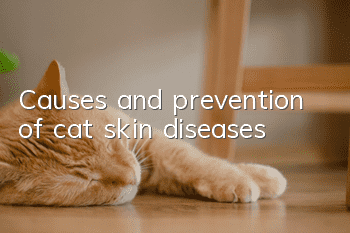Causes and prevention of cat skin diseases

Whether it is cats or dogs, skin diseases are the biggest threat to their health. Cats can often be seen losing hair. Many times we ignore or even take it seriously. Over time, skin ulcers and dermatitis appear, and the cat has to be taken care of. Go to the pet hospital to see a doctor. What are the common skin diseases in cats? How can we prevent the onset of skin diseases in cats?
【Common skin diseases】
1. Bacterial skin disease: mainly caused by bacterial infection;
2. Fungal skin disease: caused by fungal infection of the skin; skin fungi survive for a long time in nature, have strong resistance, and can survive for more than 1 year in a dry environment. There are also some fungi that have an affinity for soil and can grow and reproduce in the soil and survive for a long time. (Accounting for more than 80% of cases)
3. Ectoparasitic skin diseases: caused by fleas, scabies, demodex, ear mites, lice, ticks, etc.;
4. Metabolic skin diseases: hormonal skin diseases; allergic skin diseases;
5. Immune abnormality skin diseases: nutrition-related skin diseases, etc.
[Fungal skin diseases] Key points to understand
1. Symptoms
When cats suffer from fungal skin infections, they mostly occur on the head, ears, limbs, toes, and trunk. The skin of the affected area becomes hairless, with ring-shaped scaly spots appearing, and damaged hair roots remaining. Sometimes the affected area is completely hairless. In severe cases, erythema or scab may form. When hair begins to grow in the middle of a ringworm patch, hair loss continues around it. The affected area is itchy. If some cats are scratched and secondary bacterial infection occurs, the exudation will be severe. Redness, swelling and erosion of the skin can be seen, and in severe cases, it may become suppurative. The development of dermatomycosis generally spreads from the middle to the surrounding areas. If not treated in time, it will become chronic and have a long course. After the above symptoms appear, parents must take their cats to the veterinary hospital for examination.
2. Treatment
(1) Local treatment: It is recommended to shave the whole body of long-haired cats. For short-haired cats, the hair within six centimeters in diameter of the lesion should be shaved. When shaving, special care should be taken not to scratch the skin to avoid the spread of the lesion. For external use, it is recommended to use Trichodermazone and Trichodermazone. If it is yeast, ketoconazole should be chosen.
(2) Systemic treatment: If there is still no significant improvement after 2 to 4 weeks of local treatment, it is recommended to switch to oral drug treatment.
【Editor's comment】
If there is a window sill at home that can receive sunlight for a period of time every day, arrange a resting place for the cat there. The cat can look at the scenery outside and bask in the sun. It is important to keep it dry. However, long-term exposure may cause heat stroke and sunburn, so parents should pay attention!
- A cat will die if it urinates for a few days
- Should you deworm yourself or go to a pet store?
- Are cat teasers harmful to cats?
- What should I do if my cat suffers from chronic gingivitis?
- Cat's nails are cracked with a thin layer
- Cats go crazy after eating mutton
- What does cat moss on a cat’s chin look like?
- Can cats reproduce after abdominal transmission is cured?
- What exactly is the sterilization shot for female cats?
- Can I still eat unopened cat food if it has expired?



